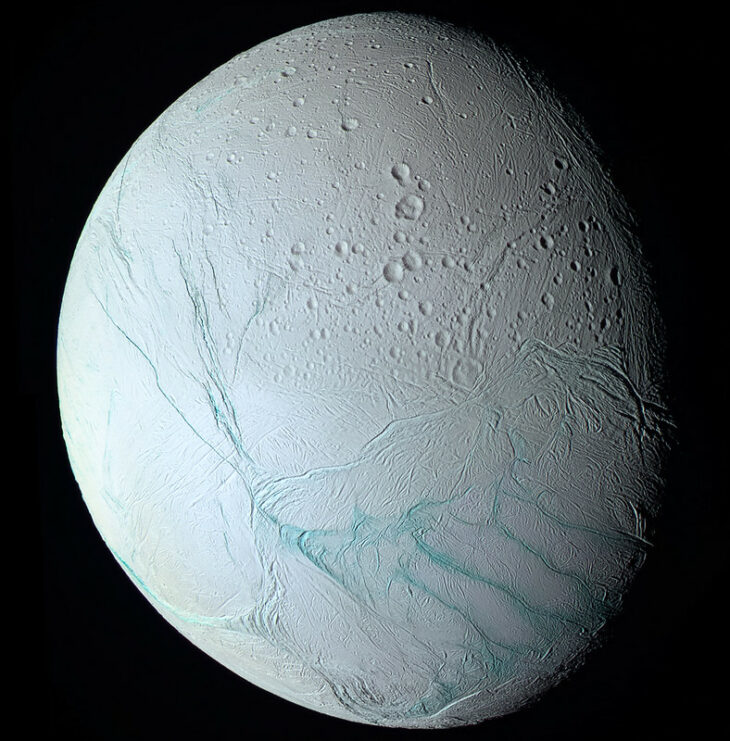The Cassini spacecraft launched in 1997 on a 7-year journey to our second closest gas giant planet, Saturn, to study more about its moons. During its 9 close targeted flybys, Cassini revealed geyser-like jets bursting from the crust of Enceladus, one of Saturn’s icy moons. After follow-up measurements of the plume’s contents, collected using Cassini’s Cosmic Dust Analyzer or CDA, the scientists think there is an ocean of liquid water beneath Enceladus’ surface, which periodically erupts into the vacuum of space forming tall plumes.
When scientists analyzed data from the CDA, they found that the plume material consists mostly of salt-rich water with small amounts of carbon dioxide, ammonia, hydrogen, and methane. The relative concentrations of each chemical varied depending on Enceladus’ position with respect to Saturn, so they proposed that the effect of Saturn’s pull on Enceladus’ crust changed the size and amounts of fractures present in its surface, ultimately affecting the plume composition.
These observations led scientists L. J. Perera and C. S. Cockell from the University of Edinburgh to hypothesize that if there is life in Enceladus’ subsurface ocean, the moon’s water plumes likely transport it out into space in tiny droplets that Cassini could find. This process of water turning into tiny droplets in space happens when moisture touches a vacuum because the low pressure transitions the liquid into a gas very quickly, in a process called rapid boiling. Nearby spacecraft can then detect and analyze these droplets. The scientists wanted to know if simple life forms like bacteria, archaea, or other microbes could survive rapid boiling and eventually be detected by a future mission.
The scientists worked with cultures of a well-studied bacterium called Bacillus subtilis. B. subtilis is known to quickly adapt to changing environmental conditions on Earth, so the researchers thought it would be a good candidate to test the dramatic changes in pressure experienced during rapid boiling. Based on the CDA measurements, the researchers prepared 2 types of possible Enceladus ocean water, one representing a salt-rich solution and the other representing a salt-poor solution. Then, they grew B. subtilis on these solutions and stained them using a dye that glows when in contact with DNA, called DYBR Gold. By looking for glowing spots, scientists can count cells and see their growth or death in a given solution over time.
The team placed the Enceladus ocean water solutions in a chamber in which they could regulate the pressure and set a clean flat dish on top of them to collect any droplets formed during the experiment. The chamber can simulate the phenomenon of rapid boiling by lowering the temperature and pressure to the precise values found on the surface of a moon around Saturn.
The researchers performed 5 runs of the same experiment for each ocean solution and collected 500 images showing over 10,000 droplets in total. Overall, the scientists found that droplets longer than 20 micrometers (0.0008 inches) had a greater chance of glowing, which meant they contained cells. Specifically, the larger droplets in the salt-rich solution had a 50% chance of containing cells, while those in the salt-poor solution had a 60% chance. The scientists attributed this difference to the bigger volume of water available to cells in the salt-depleted solution. After counting how many droplets formed in each solution type, they realized bigger droplets were more abundant in the salt-rich solutions.
With these results, the scientists argued that a salt-rich ocean would produce larger droplets in Enceladus’ plume and would have a greater chance of having detectable life. They also pointed out that their results can help structure future missions focused on finding life in Enceladus by targeting points of its orbit when the salt composition in the plumes is highest. The researchers suggested future scientists perform similar experiments using different strains of bacteria and other microorganisms to assess their tolerance to rapid boiling.


